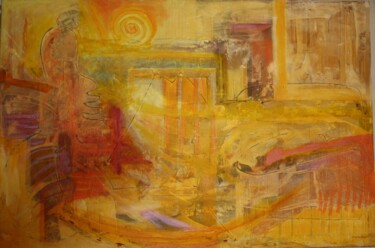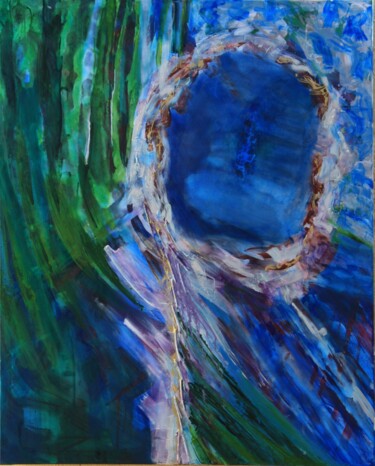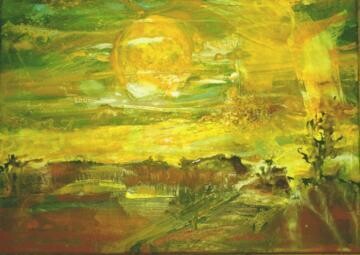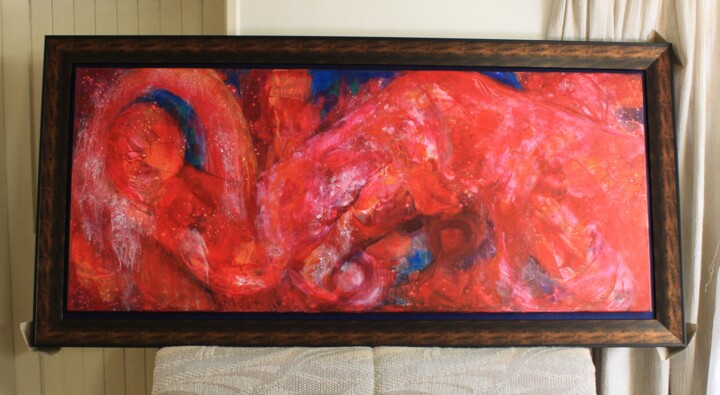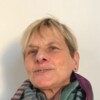Veryan Edwards
Résumé
Veryan Edwards has been living in Botswana since January 1980 and has had a studio in Gaborone since 1985. She was born in Hongkong in 1949 and spent her childhood travelling between China and the United Kingdom. Both her parents were British and on their retirement, the family lived in England for four and a half years when Veryan and her parents moved to South Africa. Veryan attended Rhodes University in Grahamstown, majoring in painting and History of Art. She went on to start a Master’s Degree in Fine Art at the University that was later completed while she was working as an art teacher in Johannesburg.
At first, Veryan worked with a friend at the St Ansgar’s Mission, Johannesburg, running a small art studio for children from Kagiso, a suburb of Soweto and producing and teaching pottery. She then worked for the African Music and Drama Association (AMDA) under Khabe Mngoma at Dorkay House. As Head of Art at AMDA, Veryan conducted classes for artists at Dorkay House and in Orlando West, Soweto and in Lenasia. She was later co-Director of AMDA and finally Director of AMDA for a couple of years. She then went to work as an art teacher at Redhill School, finally teaching all ages from kindergarten to Matriculation. In 1980, Veryan and her husband moved to the village of Kanye in Botswana and she concentrated on her studio work and a degree in Philosophy and Logic through the University of South Africa..
In March 1989, Veryan initiated the introduction of an international workshop to Botswana based on the model of the Triangle International Artists’ Workshop in New York, USA. Veryan produced the fundraising documents, set up contacts and gained the official support of the Botswana National Museum for the project, which has, however, remained independent of Government. A committee was set up through the Museum and a Trust was established so that a bank account could be opened. The first workshop took place in November 1989 in Kanye with artists from Botswana, South Africa, Zimbabwe, Zaire, the United States and the United Kingdom. As coordinator and Chairperson, Veryan organised the funding, travel, venue, accommodation, materials and equipment, booked the final exhibition and transport of works. She continued to do this for all the subsequent workshops through to 1996 and the 2001 workshop, even if she did not take part personally.
In 1995, after an inspiring visit to Zambia, Veryan initiated the idea of starting a Visual Art Centre in Gaborone and led the search for a venue. The only place available that would not require funding in the millions was a unused and decayed old house and tiny ancient battle field, which is a National monument from the Boer War. The Thapong Visual Art Centre has been established there since 1999, starting with a portacabin and tents while the Old House was renovated. Veryan was the Director of the Visual Art Centre and Chairperson of the Trust from 1999 to January, 2003. ...
Discover contemporary artworks by Veryan Edwards, browse recent artworks and buy online. Categories: contemporary botswanan artists. Artistic domains: Painting. Account type: Artist , member since 2004 (Country of origin Botswana). Buy Veryan Edwards's latest works on ArtMajeur: Discover great art by contemporary artist Veryan Edwards. Browse artworks, buy original art or high end prints.

Artist Value, Biography, Artist's studio:
Multimedia Installation Work • 7 artworks
View allArt work 2012-15 • 23 artworks
View all2011. I have been writing, collating/editing/designing a book on the Thapong International Artists' Workshop Trust 1989 - 2011. My output from the studio has been consequently smaller. The book is a fundraiser for Thapong and is going to print as I write. Otherwise, the presented are paintings and drawing done in this time. My sister also contracted adenocarcinoma and passed away on 11th November, 2012. I spent 2 months of 2012 in the USA to be with her. From 2013, I have been in the studio and working on various projects. 2014 - 2015 I was diagnosed with M.E./C FS and this has restricted my time. Hoping to be more productive as I learn to pace myself.
2010_Thoughts & Feelings • 26 artworks
View allExplorations 2006 • 10 artworks
View allInstallations 2007 • 12 artworks
View all"UNITY" exhibition 2006-7 • 44 artworks
View allTheme "Duality" • 11 artworks
View allMetaphysics is a central focus and concern that is reflected in my work that concerns not only life as it is led in Botswana but in general. Generally, the work is abstract with some occasional use of figurative images. I believe that abstraction is the style of art that leaves the viewer most open to their own perspective and interpretation and the work is thereby more interactive.
The current exhibiton, “Dualities”, reflects an interest in how life is made of opposites, each defining the other, and containing aspects of the other, such as :space” defining “form” or “hot” letting us perceive “cold”. Sometimes we balance these elements and sometimes we discover the synthesis that can arise from their combination or the “higher third” that Plato spoke about. It seems that this helps to drive life forward and is one of life’s challenges for us, dealing with differences and opposing views. The idea of “Ubuntu Civilsaiton” arose from researching the people centred values in Africa spoken about bvy Steve Biko and others. “Ubuntu” according to Makhudu (Philosophy from Africa) is about warmth, empathy, understanding, participation, sharing, harmony, cooperation, family, the Ancestors, communion of Human and Nature and much more. These are the positive attributes of Africa and are part of the ethos of the continent with all its many people. Celebrating thse values seems to be a way of integrating the opposites and the that the recognition of our common humanity is the way forward.
Theme:"Fragile" • 10 artworks
View allFor the current exhibition, “FRAGILE”, I decided to do a series of work that uses this ‘drawing’ to make comments on the nature of life as I experience it. To me, it also celebrates Africa through its flora and fauna as that is an important part of what being here means to me. I am not so much interested in arriving at the quintessential “African landscape” as talking about the fragments that I experience and which mean something to me. No-one really experiences the “whole” of anywhere. After the dust and dryness of winter, spring comes as that welcome Gift and it is what I most like to record in watercolour. I love visiting the bush and watching the life there and seeing the poignancy of tracks left in the sand; often all you ever see of the larger creatures. The comment embodied in each work is not always desperately serious because there is much joy in life if one remains grateful for what one has. Life is ephemeral so we have to engage in the moment and we are lucky if we are able to do so.
I believe that we all “frame” our experiences, which are usually fragmented. It is our understanding that allows us to see the bigger “picture”; how the fragments fit into the bigger scheme of things. The interconnectedness of life remains an ongoing issue for me and here it is represented by using netting or “spider’s web’ cloth to suspend work against a white background (the void). The frames are often incorporated into the body of the work itself and the whole piece is one unit. I enjoy working in a variety of ways and abstraction remains central to me. It is an underlying thread in all my work. I find even drawing from life is a process of abstraction – after all, Cezanne said that there are no lines in nature. We are translating what we see into something on a page; creating three dimensions on a two-dimensional surface. Sometimes, this can be “realistic” but it depends how you see and interpret things and the use of realism on paper or a canvas expresses the fragility of perception and the illusory nature of reality.
“Fragile” is about all these strands of life: illusion, the ephemeral, the fragments, the interconnections, celebrating the moment and seeing the bigger ‘picture’. I hope that it says something to you. And perhaps something beyond or beneath my immediate awareness.
I wish to thank Ann Done for the frames that have become part of the work and the Frame Gallery for the presentation of the work and the rest of the framing. I wish to express deep gratitude to Renee Eisen for her hard work in promoting this show and for enabling it to happen in the first place.
Sold Artworks • 23 artworks
Recognition
The artist's works have been noticed by the editorial staff
Biography
Résumé
Veryan Edwards has been living in Botswana since January 1980 and has had a studio in Gaborone since 1985. She was born in Hongkong in 1949 and spent her childhood travelling between China and the United Kingdom. Both her parents were British and on their retirement, the family lived in England for four and a half years when Veryan and her parents moved to South Africa. Veryan attended Rhodes University in Grahamstown, majoring in painting and History of Art. She went on to start a Master’s Degree in Fine Art at the University that was later completed while she was working as an art teacher in Johannesburg.
At first, Veryan worked with a friend at the St Ansgar’s Mission, Johannesburg, running a small art studio for children from Kagiso, a suburb of Soweto and producing and teaching pottery. She then worked for the African Music and Drama Association (AMDA) under Khabe Mngoma at Dorkay House. As Head of Art at AMDA, Veryan conducted classes for artists at Dorkay House and in Orlando West, Soweto and in Lenasia. She was later co-Director of AMDA and finally Director of AMDA for a couple of years. She then went to work as an art teacher at Redhill School, finally teaching all ages from kindergarten to Matriculation. In 1980, Veryan and her husband moved to the village of Kanye in Botswana and she concentrated on her studio work and a degree in Philosophy and Logic through the University of South Africa..
In March 1989, Veryan initiated the introduction of an international workshop to Botswana based on the model of the Triangle International Artists’ Workshop in New York, USA. Veryan produced the fundraising documents, set up contacts and gained the official support of the Botswana National Museum for the project, which has, however, remained independent of Government. A committee was set up through the Museum and a Trust was established so that a bank account could be opened. The first workshop took place in November 1989 in Kanye with artists from Botswana, South Africa, Zimbabwe, Zaire, the United States and the United Kingdom. As coordinator and Chairperson, Veryan organised the funding, travel, venue, accommodation, materials and equipment, booked the final exhibition and transport of works. She continued to do this for all the subsequent workshops through to 1996 and the 2001 workshop, even if she did not take part personally.
In 1995, after an inspiring visit to Zambia, Veryan initiated the idea of starting a Visual Art Centre in Gaborone and led the search for a venue. The only place available that would not require funding in the millions was a unused and decayed old house and tiny ancient battle field, which is a National monument from the Boer War. The Thapong Visual Art Centre has been established there since 1999, starting with a portacabin and tents while the Old House was renovated. Veryan was the Director of the Visual Art Centre and Chairperson of the Trust from 1999 to January, 2003. ...
-
Nationality:
BOTSWANA

- Date of birth : 1949
- Artistic domains:
- Groups: Contemporary Botswanan Artists
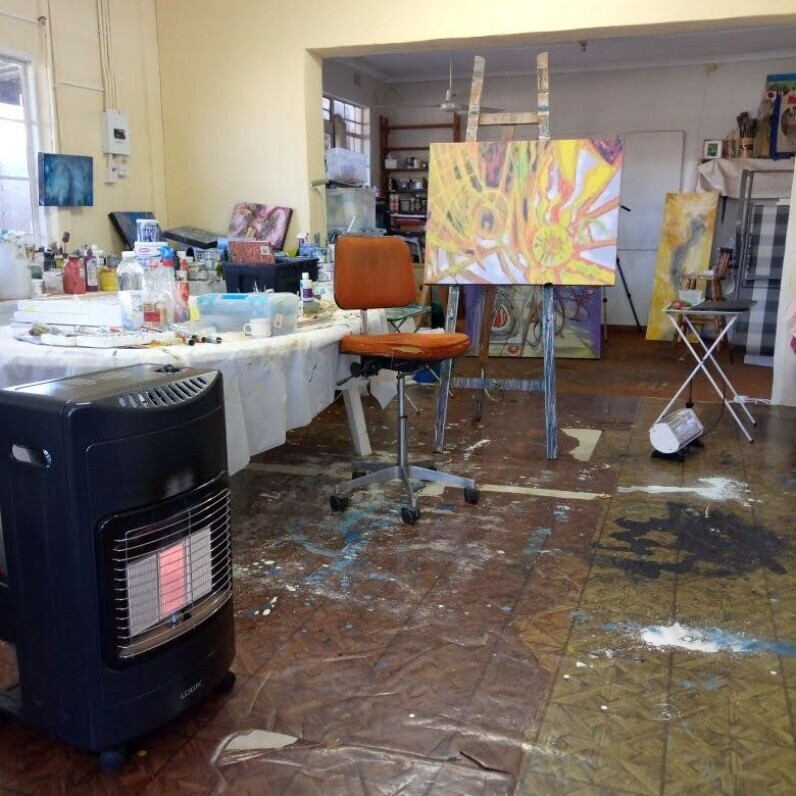
Ongoing and Upcoming art events
Influences
Education
Artist value certified
Achievements
Activity on ArtMajeur
Latest News
All the latest news from contemporary artist Veryan Edwards
Curating and exhibiting
Curating and exhibiting in a group show for Botswana Independence Day, 29th September, 2013 at the Main Gallery, Botswana National Art Gallery, Gaborone, Botswana
Press release
by Veryan Courtenay Edwards from 1st February - 28th February 2007
Press release
cordially invite you to attend the opening of
"CLOSE TO THE HEART"
an exhibition of paintings by
Veryan Edwards
At the Thapong Visual Art Centre Gallery,
opposite the Village Clinic, Gaborone
Tuesday, 3rd August, 2004
At 6.30 p.m.
The exhibition will run from 3rd - 24th August, 2004
In Africa, there is a sense of the invisible and the visible being intertwined - animals become totems and have meaning for us beyond just being there. They stand for the spirit in us all. The work is semi-abstract and a new departure for the artist.
Article
Résumé
Veryan Edwards has been living in Botswana since January 1980 and has had a studio in Gaborone since 1985. She was born in Hongkong in 1949 and spent her childhood travelling between China and the United Kingdom. Both her parents were British and on their retirement, the family lived in England for four and a half years when Veryan and her parents moved to South Africa. Veryan attended Rhodes University in Grahamstown, majoring in painting and History of Art. She went on to start a Master’s Degree in Fine Art at the University that was later completed while she was working as an art teacher in Johannesburg.
At first, Veryan worked with a friend at the St Ansgar’s Mission, Johannesburg, running a small art studio for children from Kagiso, a suburb of Soweto and producing and teaching pottery. She then worked for the African Music and Drama Association (AMDA) under Khabe Mngoma at Dorkay House. As Head of Art at AMDA, Veryan conducted classes for artists at Dorkay House and in Orlando West, Soweto and in Lenasia. She was later co-Director of AMDA and finally Director of AMDA for a couple of years. She then went to work as an art teacher at Redhill School, finally teaching all ages from kindergarten to Matriculation. In 1980, Veryan and her husband moved to the village of Kanye in Botswana and she concentrated on her studio work and a degree in Philosophy and Logic through the University of South Africa..
In March 1989, Veryan initiated the introduction of an international workshop to Botswana based on the model of the Triangle International Artists’ Workshop in New York, USA. Veryan produced the fundraising documents, set up contacts and gained the official support of the Botswana National Museum for the project, which has, however, remained independent of Government. A committee was set up through the Museum and a Trust was established so that a bank account could be opened. The first workshop took place in November 1989 in Kanye with artists from Botswana, South Africa, Zimbabwe, Zaire, the United States and the United Kingdom. As coordinator and Chairperson, Veryan organised the funding, travel, venue, accommodation, materials and equipment, booked the final exhibition and transport of works. She continued to do this for all the subsequent workshops through to 1996 and the 2001 workshop, even if she did not take part personally.
In 1995, after an inspiring visit to Zambia, Veryan initiated the idea of starting a Visual Art Centre in Gaborone and led the search for a venue. The only place available that would not require funding in the millions was a unused and decayed old house and tiny ancient battle field, which is a National monument from the Boer War. The Thapong Visual Art Centre has been established there since 1999, starting with a portacabin and tents while the Old House was renovated. Veryan was the Director of the Visual Art Centre and Chairperson of the Trust from 1999 to January, 2003. In the process she has been involved in fundraising, setting up the physical requirements and systems for the office, daily management, overseeing between eight to ten local workshops a year, overseeing the building studios, the renovation (both structural and final) of the Old Fort House, the development of the space into a Gallery and office space and installing basic utilities on the property: water, power, and sewerage. She also initiated Residencies at the Visual Art Centre in 2002, helped establish the first magazine for the Arts in Botswana, called Artefacts and designed and runs the Thapong website.
In the process of doing this, Veryan has learned a great deal about the flexibility required in working with people, and has gained in expertise and experience in teamwork, management, staff training and the nurturing of skills in others. She feels that her greatest success has been in passing on the management of the Centre to others and see it continue to develop and grow. She remains as a Trustee on the Board and continues to do voluntary work on the monthly Bank reconciliation, as one the editors of Artefacts and as the webmaster/designer for the Thapong website. Over the years she has also become proficient in basic accounting, reporting and some computer programmes: (Microsoft: Excel, Word, Publisher, PowerPoint), digital photography, Adobe Photoshop and Dreamweaver.
Veryan has been exhibiting as an artist since 1979 in solo and group exhibitions (complete list appended) The highlights include shows with artists in Botswana for the Thapong International Artists’ Workshop, Botswana and shows with other workshops to which she was invited in Zambia, Namibia, Kenya, Uganda and South Africa. She has also taken part in international workshops in Canada (Emma Lake), United Kingdom (Shave) and New York, USA (Triangle). She has taken part in many of the annual “Artists in Botswana” exhibitions in Gaborone and been part of travelling shows of Botswana art. In 1996, Veryan did a residency at the Delfina Artists’ Studio in London and held a small studio exhibition. In 2003, her work was part of a collective installation in Berlin and two works were selected for a group show “Abale” in Lusaka, Zambia. She has worked mainly in acrylics and oils in her painting and is exploring installation and mixed media as well.
Article
ARTIST’S STATEMENT
Metaphysics is a central focus and concern that is reflected in my work that concerns not only life as it is led in Botswana but in general. Generally, the painting is abstract with some occasional use of figurative images. I continually explore how best to express different levels or veils of existence or reality in me and others and how that may be best expressed and so also use installation and mixed media as alternatives to painting. I believe that the viewer should interact with the work, bringing to the experience their own perspective and interpretation, which leads them to find their own meaning, or not, in a work. These interpretations complete the work and are valid for each individual since the world is a matter of our own interpretation anyway. In this way, the works are “open-ended” and there is no attempt to try to make people see things in any particular way. At the same time, it is wonderful if the original feeling and concept of a work succeeds in being conveyed and shares something with the viewer.
The initial idea in a work is drawn from the world around me or ideas and reflections on the world around me: the landscape, people and experiences. My work reflects the landscape of Africa, having been personally transmuted to create a metaphor for an event, a time, a thought. Life seems contradictory and changeable so the work often includes intentional paradoxes of space and colour, even objects. Africa is mainly reflected in the sense of space and the colours; rich colour expresses a sense of sun and heat.
In July August 2003, the exhibition revolved around the concept of “Dualities” – how life is made of opposites, each defining the other, and containing aspects of the other, such as :space” defining “form” or “hot” letting us perceive “cold”. Sometimes we balance these elements and sometimes we discover the synthesis that can arise from their combination or the “higher third” that Plato spoke about. It seems that this helps to drive life forward and is one of life’s challenges for us, dealing with differences and opposing views. The idea for an installation called “Ubuntu Civilisation” arose from researching the people centred values in Africa spoken about by Steve Biko and others. “Ubuntu” according to Makhudu (Philosophy from Africa) is about warmth, empathy, understanding, participation, sharing, harmony, cooperation, family, the Ancestors, communion of Human and Nature and much more. These are the positive attributes of Africa and are part of the ethos of the continent with all its many people. Celebrating these values seems to be a way of integrating the opposites and that the recognition of our common humanity is the way forward. The exhibition in September/October 2003 revolved around the concept of “Fragility”. Our time here seems so fleeting; the world around us is subject to constant change so that only a brief moment of it can be captured and frozen in time. I love visiting the bush and watching and drawing the life there and seeing the poignancy of tracks left in the sand; often all you ever see of the larger creatures. The comment embodied in each work marks the passing of things within the web of our being, for which one remains grateful. Life is ephemeral so we have to engage in the moment.
Generally, I believe that our interaction with the world is filtered through our view of it: our perception, principles, values and actions are based on what we understand of the nature of reality. My interpretation is that we live in a spiritual universe comprised of energy in varying forms and it is this energy that goes beyond self and which is shared with the viewer.
Veryan Edwards
Gaborone, Botswana
24/05/2004
Expos Collective (Listing)
GROUP EXHIBITIONS
2003 “Abale” International Cont. Art, Norsad Agency Office, Lusaka, ZAMBIA (selected by David Chirwa, Zambia, N’Gone Fall, Senegal, William Bwalya Miko, Zambia)
2003 “Ongoing Connections”, National Museum, Monuments & Art Gallery, Gaborone, BOTSWANA
2003 “Transportale”, Von Buch bis Lichtenrade and ausgewahlten Stationen und in der S-Bahn, Berlin,
GERMANY
2002 “African Moments” installation exhibition with Hercules Viljoen and Neo Matome, Main Gallery, National Museum, Monuments & Art Gallery, BOTSWANA
2002 “Visions of Peace” Thapong exhibition celebrating the International Day of Peace with UNESCO at
Alliance Française Gallery, Gaborone, BOTSWANA
2001 “Alternative Thapong” - Main Gallery, National Museum, Monuments & Art Gallery, BOTSWANA
2001 Tulipamwe International Artists’ Workshop Show, Alliance Francaise, Windhoek, NAMIBIA
2001 “AIDS/HIV Exhibition ”- Main Gallery, National Museum, Monuments & Art Gallery, BOTSWANA
2000 “Open Studio Show” – Triangle International Artists’ Workshop, NEW YORK, USA
2000 “SADC 2000” – National Gallery, Windhoek, NAMIBIA
2000 Wasanii International Artists’ Workshop Exhibition, National Museum, Nairobi, KENYA
2000 “Stuff 2000”- Main Gallery, National Museum, Monuments & Art Gallery, BOTSWANA
1999 “University of Botswana Show”, University of Botswana, Gaborone, BOTSWANA
1999 “7 Women” –Main Gallery, National Museum, Monuments & Art Gallery, BOTSWANA
1998 “Thapong Now and Then”, National Museum, Monuments & Art Gallery, Gaborone, BOTSWANA
1998 Ngoma International Artists’ Workshop group exhibition, Kampala, UGANDA [inaugural show]
1997 Artists in Botswana, National Museum, Monuments and Art Gallery, Gaborone [awarded a Special Mention] BOTSWANA
1996 Thapong International Artists’ Workshop group exhibition, National Museum, Gaborone. BOTSWANA
1995 South African Africus Biennale, Johannesburg, SOUTH AFRICA
1995 Mbile International Artists’ Workshop exhibition, Lusaka, ZAMBIA.
1995 Thapong International Artists’ Workshop exhibition, National Museum, Gaborone. BOTSWANA
1995 Little Picture Show, Gallery Ann, Gaborone BOTSWANA
1995 All Africa Exhibition of Contemporary Art; National Gallery in Bulawayo, ZIMBABWE
1994 Orchard Studios Workshop Exhibition, Johannesburg Art Foundation, Johannesburg, SOUTH AFRICA
1994 Thapong International Artists’ Workshop exhibition National Museum, Gaborone. BOTSWANA
1993 Artists in Botswana, National Museum and Art Gallery, Gaborone, BOTSWANA
1993 Thapong International Artists' Workshop group exhibition National Museum, Gaborone. BOTSWANA
1992 Artists in Botswana, National Museum and Art Gallery, Gaborone, BOTSWANA
1992 the Gallery's framer inc. Gallery, Saskatoon, CANADA
1992 Gallery in remembrance of Bill Ainslie, Cyrene Mission, Bulawayo, ZIMBABWE
1991 Artists in Botswana, National Museum and Art Gallery, Gaborone, BOTSWANA
1991 UNICEF exhibition in aid of disadvantaged children, National Museum and Art Gallery, Gaborone, BOTSWANA
1991 Thapong International Artists' Workshop group exhibition National Museum, Gaborone. BOTSWANA
1990 Artists in Botswana, National Museum and Art Gallery, Gaborone, BOTSWANA
1990 Group exhibition: Pachipamwe International Artists' workshop, Harare and Bulawayo, ZIMBABWE.
1990 Thapong International Artists' Workshop group exhibition National Museum, Gaborone. BOTSWANA
1989 Artists in Botswana, National Museum and Art Gallery, Gaborone, BOTSWANA
1989 Inaugural : Thapong International Artists' Workshop National Museum, Gaborone. BOTSWANA
1981 Exhibited with Thamaga Pottery, National Museum and Art Gallery, Gaborone, BOTSWANA
1979 Bill Ainslie Studio Exhibition, Johannesburg SOUTH AFRICA
1976 Arts Festival exhibition, Carlton Centre, Johannesburg SOUTH AFRICA
1975 "Art South Africa Today": adjudicated by Clement Greenberg SOUTH AFRICA
1971 Group exhibition: Rhodes University exhibition – Johannesburg SOUTH AFRICA
Expos Solo (Listing)
SOLO EXHIBITIONS
2003 “Fragile”, The Frame Gallery, Gaborone, Botswana (October – December)
2000 “Reality Check”, Botswanacraft Gallery, Gaborone, BOTSWANA
1998 “Earth & Sky”, The National Museum, Monuments & Art Gallery, Main Gallery, Gaborone, BOTSWANA
1996 · “Botswana Thoughts”, The National Gallery in Bulawayo, ZIMBABWE
· “Thoughts in Space and Colour”, Delfina Artists’ Studios, LONDON, ENGLAND
1994 Gallery Ann and Sheraton Hotel, Gaborone, BOTSWANA.
1988 National Museum and Art Gallery, Gaborone, BOTSWANA
1985 Alliance Francaise, Gaborone, BOTSWANA
1977 Exhibition towards MFA, Rhodes University, SOUTH AFRICA
TWO-PERSON EXHIBITIONS
2003 “Dualities” – exhibition with Neo Matome, Main Gallery, Botswana National Museum, Gaborone
1995 Lower Gallery, National Museum and Art Gallery, Gaborone, Botswana.
Upper Gallery: Neo Matome
1990 Lower Gallery, National Museum and Art Gallery, Gaborone, Botswana.
Upper Gallery: K. Bremberg
Reviews and comments
